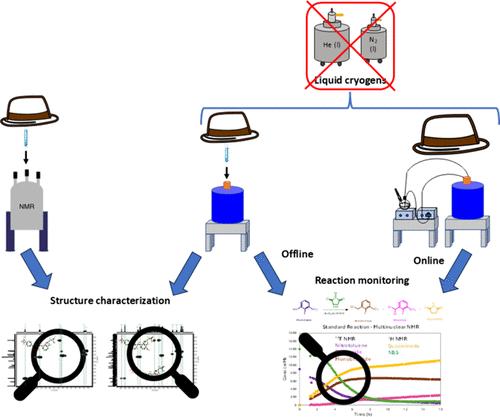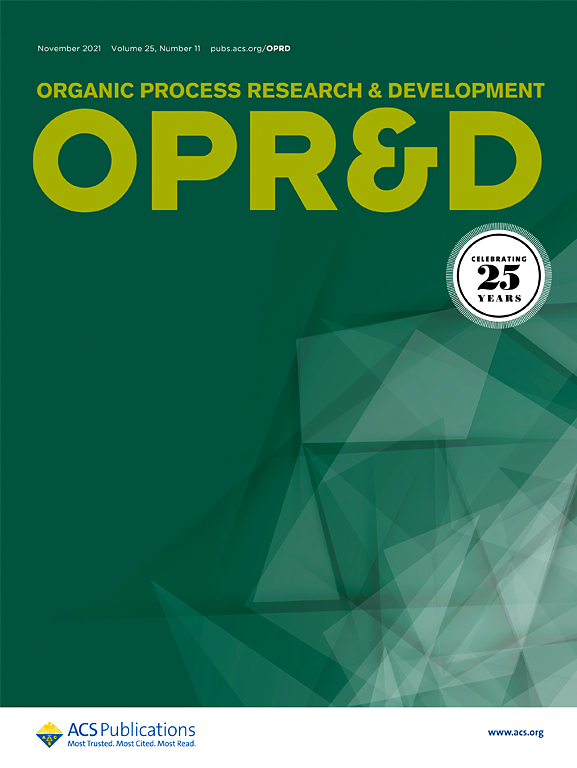核磁共振侦探社:为过程化学家揭开真相
IF 3.5
3区 化学
Q2 CHEMISTRY, APPLIED
引用次数: 0
摘要
核磁共振起着“侦探作用”,通过观察和数据分析充当“放大镜”,促进化学问题的详细可视化,提供解决方案;因此,核磁共振是扩大药物开发阶段和准备商业监管批准过程中分析控制策略的重要组成部分。核磁共振是药物开发过程中有机杂质结构表征的关键分析技术,支持过程化学家分析控制策略的工作。在过去的十年中,核磁共振在研究反应机制、过程理解和改进大规模药物工艺以支持制药工业的临床试验方面发挥了重要作用。这些机理调查研究是提高原料药合成中材料的质量、效率和产量的关键,提供了直接影响放大过程及其分析控制策略性能的缓解途径。在大规模化学反应过程中,药物杂质的结构解析和反应机理的研究已成为核磁共振的主要“探测角色”,为药物在工艺开发过程中提供更好的控制策略。此外,其他现有的核磁共振方法和技术可能会对扩大核磁共振作为过程化学家分析控制策略的一部分的“探测作用”产生影响。这些方法包括:测定手性药物立体异构体相对构型的核磁共振各向异性、用低场时域核磁共振(TD)定量其配制药品中的氟化药物物质、作为非破坏性和非侵入性技术测定密封小瓶中冻干物质含水量的低场TD-NMR、以及低场台式核磁共振和高场无低温核磁共振作为PAT工具在制造工厂化学过程实时反应监测中的应用。核磁共振在药物开发中的“探测作用”提供了基于过程理解知识的解决方案,这对于过程化学家实施适当的分析控制策略起着关键作用。本文章由计算机程序翻译,如有差异,请以英文原文为准。

NMR Detective Agency: Uncovering the Truth for Process Chemists
NMR plays a “detective role” that through observation and data analysis acts as a “magnifying lens” facilitating the visualization of chemical problems in detail to provide solutions; therefore, NMR is an essential part of analytical control strategies during scaling up drug development stages in preparation of commercial regulatory approval. NMR is a critical analytical technique for the structure characterization of organic impurities during drug development, supporting the work of process chemists for analytical control strategies. During the past decade, NMR has played an important role in investigating reaction mechanisms for process understanding and improvement on scale-up drug processes to support clinical trials in the pharmaceutical industry. Those mechanistic investigation studies are key to improving the quality, efficiency, and yield of materials in the APIs syntheses, providing mitigation pathways that directly impact the performance of scale-up processes and their analytical control strategies. Structure elucidation of drug impurities and investigations of reaction mechanisms during scale-up chemical reactions have become the principal “detective roles” of NMR, providing better control strategies for drugs during process development. In addition, other existing NMR methodologies and technologies may provide impact expanding the “detective role” of NMR as part of the analytical control strategies for process chemists. Those methodologies are NMR anisotropy for the determination of relative configuration of stereoisomers of chiral drugs, quantitation by low field time-domain (TD) NMR of fluorinated drug substances in their formulated drug products, low field TD-NMR for the water content of lyophilized materials in sealed vials as a nondestructive and not invasive technique, and the application of low field benchtop NMR and high field cryogen-free NMR as PAT tools in real-time reaction monitoring of chemical processes in the manufacturing plant. The “detective role” of NMR in drug development provides solutions based on knowledge of process understanding for improvement, which plays a critical role in implementing appropriate analytical control strategies for process chemists.
求助全文
通过发布文献求助,成功后即可免费获取论文全文。
去求助
来源期刊
CiteScore
6.90
自引率
14.70%
发文量
251
审稿时长
2 months
期刊介绍:
The journal Organic Process Research & Development serves as a communication tool between industrial chemists and chemists working in universities and research institutes. As such, it reports original work from the broad field of industrial process chemistry but also presents academic results that are relevant, or potentially relevant, to industrial applications. Process chemistry is the science that enables the safe, environmentally benign and ultimately economical manufacturing of organic compounds that are required in larger amounts to help address the needs of society. Consequently, the Journal encompasses every aspect of organic chemistry, including all aspects of catalysis, synthetic methodology development and synthetic strategy exploration, but also includes aspects from analytical and solid-state chemistry and chemical engineering, such as work-up tools,process safety, or flow-chemistry. The goal of development and optimization of chemical reactions and processes is their transfer to a larger scale; original work describing such studies and the actual implementation on scale is highly relevant to the journal. However, studies on new developments from either industry, research institutes or academia that have not yet been demonstrated on scale, but where an industrial utility can be expected and where the study has addressed important prerequisites for a scale-up and has given confidence into the reliability and practicality of the chemistry, also serve the mission of OPR&D as a communication tool between the different contributors to the field.

 求助内容:
求助内容: 应助结果提醒方式:
应助结果提醒方式:


